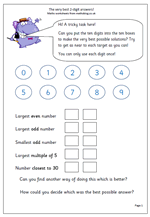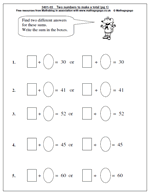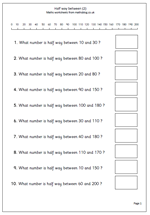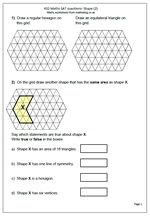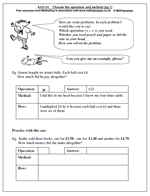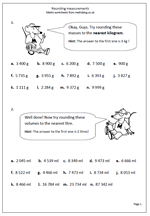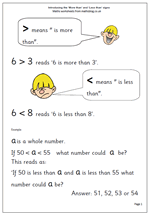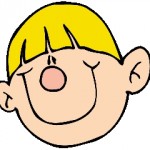 In year 3 one of the major areas of progress is in using written methods for working out harder addition, subtraction, multiplication and division. At first these will not be the shortened ‘standard’ methods which we use, but steps towards them and may well take the form of jottings. However, the emphasis is still on mental calculations and a question should only be done on paper if it can’t be done mentally. To help with mental arithmetic more tables are to be learned by heart including the 6x table.
In year 3 one of the major areas of progress is in using written methods for working out harder addition, subtraction, multiplication and division. At first these will not be the shortened ‘standard’ methods which we use, but steps towards them and may well take the form of jottings. However, the emphasis is still on mental calculations and a question should only be done on paper if it can’t be done mentally. To help with mental arithmetic more tables are to be learned by heart including the 6x table.
Remember to look at the year 2 expectations to see the progression.
Counting and understanding number:
By the end of year 3 children should
• be able to read, write and order whole numbers up to at least 1 000.
(eg write in figures: four hundred and nine.)
• be able to order numbers and position numbers on a number line.
(eg which is more 315 or 513?)
• be able to count on and back in single digits.
(eg count on six from 97.)
• be able to count on and back in multiples of 10.
(eg count back in tens from 83 to 23.)
• partition 3-digit numbers into hundreds, tens and units.
(eg know that 547 is 500 + 40 + 7.)
• round 2-digit or 3-digit numbers to the nearest 10 or 100.
(eg round 255 to the nearest 100.)
• give estimates for addition and subtraction questions.
(eg 56 + 43 is about 100.)
• read and write proper fractions.
(eg 3/5.)
• know and understand the meaning of denominator and numerator.
eg know that the denominator in 3/7 is seven.)
• recognise fractions of shapes and compare fractions and then begin to see equivalence between fractions.
(eg 2/3 = 4/6.)
Knowing and using number facts:
By the end of year 3 children should
• know by heart all addition and subtraction facts up to 20.
(eg 8 + 6 = ?)
• derive and recall sums of multiples of 10.
(eg 40 + 50.)
• derive and recall differences of multiples of 10.
(eg 60 – 40.)
• derive and recall number pairs that total 100.
(eg 45 + 55.)
• know 2, 3, 4, 5, 6 and 10 times tables and derive corresponding division facts.
(eg work out 54 divided by 9 by knowing that 9 x 6 = 54.)
• recognise multiples of 2, 5 or 10 up to 1 000.
(eg know that 65 is a multiple of 5.)
• use their knowledge to estimate and check answers.
(eg give an estimate for 96 + 57.)
Calculating:
By the end of year 3 children should
• be able to add combinations of 1-digit and 2-digit numbers mentally.
(eg add 5, 11 and 4.)
• be able to subtract 1-digit numbers from 2-digit numbers mentally.
(eg subtract 8 from 25.)
• use written methods for addition of 2-digit and 3-digit numbers: but not necessarily the standard method.
(eg 86 + 67.)
• use written methods for subtraction of 2-digit and 3-digit numbers: but not necessarily the standard method.
(eg 63 – 38.)
• multiply 1-digit or 2-digit numbers by 10 or 100.
(eg 26 x 10.)
• use informal written methods to multiply 2-digit numbers
(eg 17 x 3).
• use informal written methods to divide 2-digit numbers.
(eg 17 divided by 3.)
• know when to round remainders up or down.
(eg the number of 5 seater taxis needed for 16 people: 3 remainder 1, means 4 taxis are needed.)
• understand that division is the inverse of multiplication and vice versa.
(eg if 7 x 5 = 35 then 35 divided by 7 is 5.)
• Find unit fractions of numbers and quantities.
( eg find 1/5 of 20.)
Understanding shape:
By the end of year 3 children should
• be able to relate 2-D and 3-D shapes to drawings of them.
(eg using cubes make a solid from its picture.)
• describe, draw and make shapes.
(eg put two triangles together to make a quadrilateral.)
• draw the reflection of a shape in a mirror line.
(eg find letters of the alphabet with reflective symmetry.)
• use the 4 compass directions to describe movement on a grid.
(eg use squared paper and a counter to move 2 squares north…etc.)
• read and record the vocabulary of position, direction and movement.
(eg know and use diagonal, forward, backward etc.)
• use a set square to draw and identify right angles.
• compare angles with a right angle, saying whether they are more or less.
• recognise that a straight line is equivalent to two right angles.
Measuring:
By the end of year 3 children should
• know the relationship between kilometres, metres and centimetres.
(eg know there are 1000 metres in a kilometre.)
• know the relationship between kilograms and grams.
• know the relationship between litres and millilitres.
• choose and use appropriate units to estimate and measure.
• read scales to the nearest division and half division.
• measure and draw to a suitable degree of accuracy.
• read the time on a 12 hour digital clock.
• read the time to the nearest 5 minutes on an analogue clock.
• calculate time intervals between events.
Handling data:
By the end of year 3 children should
• answer a question by collecting, organising and interpreting data.
• use tally charts, frequency diagrams, pictograms, and bar charts.
• use Venn diagrams and Carroll diagrams to sort data and objects.
Using and applying mathematics:
By the end of year 3 children should
• solve one step problems involving numbers, money, measures, time.
(eg an egg weighs about 50g. About how much do 6 eggs weigh?)
• solve two step problems involving numbers, money, measures, time.
(There are 15 books on the top shelf and 13 books on the bottom. 6 books are removed. How many are left?)
• solve puzzles using numbers or diagrams.
(eg solve a magic square.)
• investigate by following a line of enquiry, organising information in tables, graphs etc.
(eg find how many biscuits are eaten each day for a week.)
• investigate patterns in numbers and shapes and use these to solve problems.
(eg if you multiply numbers either way round the answer is always the same.)
• describe and explain choices made in deciding how to solve a problem, orally and in writing.
(explain how to go about finding a pair of numbers which has a sum of 7 and a product of 10.)
